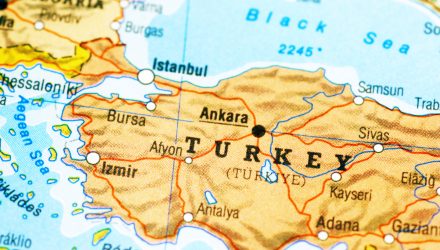That leaves a positive performance difference of 4.79% to the hedged investor that needs to be accounted for. Well the majority of it is composed of two things – the weighted currency return (shown in the table as “impact”), and the cost to hedge emerging market currencies (not shown, but currently around -1.40% per annum). Impact measures the year to date return of each currency, weighted by its size in the unhedged fund. So, it controls for the currencies where investors should care more. And, while it’s clear from the table that the Turkish lira is having the worst year, by far, of all the currencies in the fund in return terms, it should also be clear that it’s relatively small weight mutes the impact. One can see at a glance that, despite being down less than the lira, it is in fact the Brazilian real, the South African rand, the Indian rupee, the Korean won, the Russian ruble, and the Taiwanese dollar that have all been more influential so far this year, because of their heavier weights.
In fact, we can be more specific, and conclude that, of the -5.31% return to the weighted currency basket, the Turkish lira only accounts for around 5% of this performance gap (ignoring cost to hedge, and the math is simply -0.26% as a percentage of -5.31%). The “top five” currencies by impact are the real, the rand, the rupee, the won, and the ruble. These five have accounted for almost 80% of the differential this year between hedged and unhedged performance. Indeed, it’s the Brazilian real has been most critical, alone accounting for around a quarter of the unhedged investor’s underperformance.
Finally, you may be wondering why, in eliminating exposure to a currency basket that is down -5.31% year-to-date, a hedged investor “only” has outperformance of 4.79%? Well, there will be other things going on – including transaction costs and tracking issues – but a large part of the difference also comes from the cost to hedge EM currencies. That cost is currently around -1.40% per annum to the U.S. investor, but is has come down over recent years as the U.S. Federal Reserve (the Fed) has put rates up and other countries (notably Brazil in fact) have lowered their interest rates (rate differentials are the main component of hedging costs).
So, amongst all the headlines, always ask yourself not just what an individual stock or currency’s absolute performance has been, but also its relative weight in the portfolio. The two together show the impact on a portfolio and, in the case of Turkey, it should be clear that the column inches are at odds with the bottom line.
